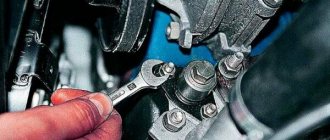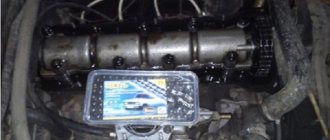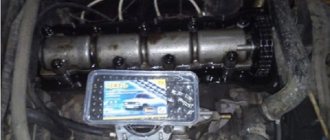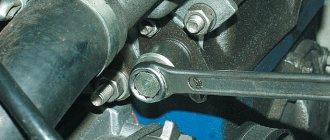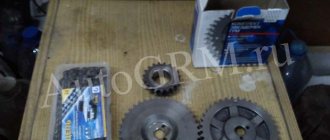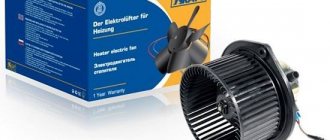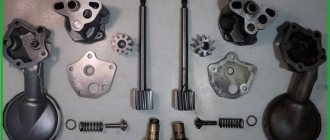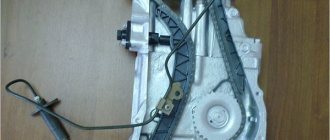If you notice that at idle the engine power unit, especially the injector, has begun to operate unevenly, then you need to check the timing chain tension. The malfunction may be hidden both in it and in the tensioner, which can collapse due to sagging of the belt. In this case, the edge of the shoe may break off or a defect in the limit pin may appear. Let's figure out how to replace the timing chain tensioner on a VAZ-2107 car.
VAZ 2107 TIMING CHAIN DRIVE - DESCRIPTION
The VAZ 2107 timing chain transmission has a long service life, but someday it’s time to replace it. The need for this arises as a result of stretching of the links, when the chain tensioner can no longer cope with the functions assigned to it. In addition, the parts responsible for the normal operation of the timing drive also wear out over time.
The main elements of the VAZ 2107 timing drive are a chain, a damper, a shoe, a tensioner and sprockets
SOOTHER
In the chain drive of the VAZ 2107 gas distribution mechanism, a damper is used to dampen jerks and vibrations of the chain. Without this part, as the vibration amplitude increases, the chain may fly off the gears or break completely. A chain transmission break is most likely at maximum crankshaft speed, which happens instantly. At the moment of a break, the intake and exhaust valves fail. After such damage, the engine will at best require a major overhaul.
The chain damper is designed to dampen vibrations of the chain drive during engine operation.
By its design, the damper is a plate made of high-carbon steel with two holes for fastening. Another element that is simultaneously responsible for calming and tensioning the chain is the shoe. Its rubbing surface is made of high-strength polymer material.
The tensioner shoe provides chain tension, eliminating sagging
TENSIONER
Based on the name, you can understand that the device is designed to prevent sagging of the timing chain while the engine is running. There are several types of such mechanisms:
- automatic;
- mechanical;
- hydraulic.
Automatic tensioners appeared not so long ago, but have already managed to show their positive and negative sides. The main advantage of the product is that there is no need to periodically adjust the chain tension, since the mechanism keeps it constantly taut. The disadvantages of the auto tensioner include quick failure, high cost, and poor tension, as evidenced by reviews from some car owners.
Hydraulic tensioners operate as a result of the action of oil under pressure, which is supplied from the engine lubrication system. This design does not require intervention from the driver in terms of adjusting the chain drive, but the mechanism can sometimes jam, which negates all its advantages.
The most common tensioner is mechanical. However, it has a significant drawback: the product becomes clogged with small particles, as a result of which the plunger jams and the mechanism is unable to perform its functions during tension adjustment.
The tensioner provides chain tension and allows for adjustments when needed.
CHAIN
The timing chain in the VAZ 2107 engine is designed to connect the crankshaft and camshaft: they have gears on which the chain is put. After starting the power unit, synchronous rotation of the indicated shafts is ensured through a chain transmission. If synchronization is disrupted for any reason, the timing mechanism malfunctions, resulting in the stable operation of the engine being disrupted. In such a situation, power failures, deterioration in dynamics, and increased fuel consumption are observed.
The timing chain in the VAZ 2107 engine is designed to connect the crankshaft and camshaft
As the vehicle is used, the chain stretches as high loads are placed on it. This indicates the need for periodic adjustment. Otherwise, the sagging will lead to the links on the gears jumping, which will disrupt the operation of the power unit. To prevent this from happening, the factory recommends adjusting the chain tension every 10 thousand km. mileage
If the camshaft fails
The camshaft on the VAZ 2106 model is rarely dismantled. Typically during repair or disassembly. Sometimes to replace it.
Signs
First, let's talk a little about the signs that indicate that the camshaft is faulty, its journals or beds are worn out. It is difficult to determine whether the shaft or something else is knocking in the VAZ 2106 engine, but it is possible. The knock of the camshaft is dull and clearly audible. As engine speed increases, the knocking becomes more frequent.
Some drivers determine knocking in this unit using a stethoscope or a stick through the valve cover. But often it is difficult for an inexperienced driver to do this. Therefore, the best way to diagnose the camshaft is to remove it, wash it and inspect it.
If the camshaft is faulty, the following symptoms may occur:
- a dull knock, reminiscent of hammer blows;
- it is impossible to adjust the valve clearances; while the crankshaft is turning, the camshaft is constantly in different positions.
This video shows how you can eliminate longitudinal runout of a camshaft.
The most reliable method for diagnosing problems with the VAZ 2106 camshaft is to dismantle it from the car and wash it. You can wash it in gasoline or other cleaning liquid. Next, you need to hold the shaft and hit the bed, when you hear the slightest knock, we determine whether the mechanism is worn out. Be sure to make sure that the shaft does not move in bed, because when it hits the limiter it will make a dull knock.
Removed shaft
The camshaft has a great influence on the pressure in the lubrication system. If the gaps between the bed and the camshaft are large, then the pressure will be low, and as a result, unsatisfactory lubrication of other parts.
Causes
The main malfunctions that result in the need to replace the camshaft are its wear, the appearance of various scuffs and grooves on the bearing journals. Likewise, replacing the camshaft is necessary if it is found to be deformed or cracked. When such malfunctions occur, the power unit loses power and also begins to function intermittently. Problems with the camshaft are identified by a knocking sound in the cylinder head.
The camshaft on the “six” is rarely removed. In addition to the above reasons for replacing and reconfiguring the power unit. After this, you can notice a significant increase in power, like in sports cars.
How to install roller damper and rockring
- First, you need to make sure that the bike frame supports the “calm” setting. To do this, on the right side of the frame, on the carriage assembly, there must be special mounting ears with holes for bolts. If there are any, then the frame supports the installation;
- After making sure that installation is possible, it is necessary to remove the crank (connecting rod) from the bicycle frame along with the sprockets from the fastener side, and also dismantle the carriage or carriage cup, if this is possible. For this stage you will need a connecting rod puller, which requires a wrench and a carriage puller, depending on the type of which you may need a wrench;
- After this procedure, install the structure according to the mounting holes. It is worth remembering that after installing the carriage stabilizer, the chainline changes, so when installing the carriage in the seat, it is necessary to adjust this indicator using spacer rings. For this step you will need hexagons or a Phillips screwdriver, depending on the type of bolts on the bicycle carriage;
- After installing the carriage and adjusting it, you should reinstall the crank with stars. At this stage, the rockring is installed, which is installed instead of or on top of the outermost drive sprocket of the bicycle. In order to put on the rockring, you need to unscrew the bonnets with hexagons (the bolts that secure the front stars together), and then return them to their place;
- Next, put the chain on the bike and adjust the “calm down” rollers so that its operation is correct;
- Depending on the type of “changeguide” design, the installation of the chain occurs in the assembled or unfastened state, where in the latter it will be necessary to pull the chain through the roller. At this stage, you will need screwdrivers to adjust the rollers and other parts of the damper;
- After all installations and final checks have been completed, the chain tension should be checked. To do this, you need to switch from one speed to another, thereby finding out whether it is necessary to lengthen or shorten the length of the chain so that the “calm down” adequately performs its function.
How to correctly replace a chain guide on a VAZ-2107
To correctly carry out the procedure for replacing the timing chain guide, you need to prepare the tools for the job:
- Screwdriver Set;
- a set of keys;
- set of socket heads;
- long tweezers (you can use a wire hook instead).
In addition to tools, you will need a new damper, engine head cover gasket and special sealant for cars.
This procedure can be performed independently in a garage. In this case, the following conditions must be observed:
- spacious room;
- bright lighting;
- absence of dust (it should not get on the parts of the gas distribution mechanism when the cover is removed).
The first step is to remove the chain guide. This process consists of several steps (with the car in running mode at neutral speed):
Remove the engine head cover by first unscrewing the eight mounting bolts (note: the gasket must not be damaged, otherwise it will need to be replaced). Align the camshaft sprocket (the mark on it should coincide with the boss on the camshaft housing). Partially unscrew the tensioner cap nut for the timing chain structure (it should be loosened slightly without unscrewing completely). Press the tensioner shoe using a suitable screwdriver to loosen the tensioned timing chain structure. Screw the cap nut into place to secure the chain in the loose position. Hook the tensioner with tweezers or a hook (the hooking tool must be inserted into the technological hole) so that the dismantled part does not fall into the engine oil pan during dismantling. Unscrew the chain guide mounting bolts (there are two of them). Dismantle it.
If the damper breaks, it can be removed with tweezers or a stiff wire hook. If during dismantling this part fell into the engine crankcase pan, it will be necessary to remove this pan to remove the damper.
The second stage is the installation of a new chain guide. The procedure is the reverse of that described above. When performing this, several important points should be taken into account:
- Be sure to tension the chain structure to the required level.
- The location of the engine shaft marks - crankshaft and camshaft - is monitored.
- All seats for bolted fastenings are coated with automotive sealant (this measure is necessary to prevent engine oil from seeping through).
If it is difficult for a car enthusiast to carry out the procedure for replacing the chain guide on his own, he can always seek help from qualified car mechanics at a service center for the repair and maintenance of cars of this model.
Step-by-step instruction
Before starting work on tensioning the chain, the car must be placed in a comfortable position. Place the gearshift knob in the neutral position and secure the wheels so that the car does not roll during the procedure.
Tools
To carry out the work, the following tools are required:
- set of socket wrenches;
- set of heads;
- pliers;
- screwdriver;
- hammer.
Before starting work, you should make a visual inspection of the chain drive. If mechanical damage is found to the tension roller, shoe, guide, sprockets or chain, the defective parts must be replaced.
TYPES OF CHAIN DRIVE
The VAZ “Seven”, like other “classics”, is equipped with a double-row timing chain. However, there is a single-row chain that, if desired, can be installed on a Zhiguli.
SINGLE ROW CHAIN
A chain drive with one row has less noise when the engine is running compared to two rows. This factor is one of the main factors in favor of choosing single-row chains. Therefore, some VAZ 2107 owners decide to replace the timing drive. The lower noise level is due to the fact that fewer links are driven. Plus, it is easier for the entire engine to rotate such a chain, which has a positive effect on the increase in power. However, due to the low noise level when such a chain is stretched, it is not always clear that the part needs tension.
Single row timing chain has lower noise levels
DOUBLE-ROW CHAIN
Despite the advantages of a single-row chain, a chain drive with two rows is the most common, since it is characterized by high reliability and if a link breaks, the entire chain does not break. In addition, the load on the timing drive parts is distributed evenly, as a result of which the chain and gears wear out more slowly. The life of the part in question exceeds 100 thousand km. Although recently, in order to reduce the weight of power units, automakers have been installing chains with one row.
The double-row chain, despite its higher noise level, has a long service life
REPLACING A DOUBLE-ROW CHAIN WITH A SINGLE-ROW CHAIN
If you are thinking about replacing a double-row chain drive with a single-row one, you will need to purchase the following parts:
- crankshaft, camshaft and oil pump gears for single row chain;
- sedative;
- shoe;
- single-row chain;
- automatic tensioner.
To install a single row chain, you will need to replace the gears, chain, guide and timing chain tensioner
All of the listed parts are taken, as a rule, from the VAZ 21214. Replacing the chain should not cause difficulties. The only thing that is required is to replace the sprockets, for which you unscrew the corresponding fasteners. Otherwise, the steps are similar to the procedure for replacing a conventional double-row chain.
VIDEO: INSTALLING A SINGLE-ROW CHAIN ON A VAZ
Despite the fact that replacing the timing chain drive on a VAZ 2107 is not an easy process, every owner of a Zhiguli can do it if you follow the step-by-step instructions. The main thing is to correctly set the marks upon completion of the work, which will ensure synchronous operation of the crankshaft and camshaft.
Step-by-step instruction
Before starting troubleshooting, check that all timing components are free of mechanical defects. To do this, you need to remove the protective cover of the drive and perform a visual inspection of the parts: sprockets, damper, tensioner and shoe. If defects are found, these components should be replaced.
Tools
Before you start work, you need to prepare the necessary tools:
To carry out work, the car should be placed on a convenient platform and supports should be placed under the wheels so that it does not roll. The gear shift lever must be set to neutral.
Read more: Installing speakers in the front doors on a Lada Granta
Engine compartment of VAZ 2101
Checking tension with a screwdriver
After tightening the chain drive, you should start the engine and check its operation. It should work without extraneous noise. If the noise remains after tensioning, then the reason may be in the damper. Then you need to check its serviceability and replace it if necessary. It may not be possible to tension the chain drive the first time, so this procedure will have to be repeated several times.
This operation should be carried out every time after any repair work. In addition, a preventive check should be performed after the 10 thousand kilometers mark. If you learn how to check and tension yourself, this will make it possible to extend its service life and save on car service costs.
Procedure for tensioning or replacing the timing chain
As the vehicle operates, the timing chain, which operates under high voltages, is gradually stretched. Because of this, the chain pitch may change and the engine begins to operate unstably at idle. Floating speeds appear. It is even possible for the chain to jump several links and then the internal combustion engine will begin to stall. To prevent this, experts recommend periodically adjusting the chain tension. If the driver heard that the VAZ 2107 chain is rattling, this is a sure sign that on the VAZ 2107 chain tension is simply necessary.
How to tension a chain on a VAZ 2107 - this can be done in several ways. Car enthusiasts choose any of them based on experience and time available for work.
To begin with, you need to place the car on level ground and secure the wheels with chocks so that it does not move, and also set the gearshift knob to the “neutral” position. Before starting work, you need to prepare a tool - a wrench for “13” and “36”, sockets for “8” and “10”, pliers and a screwdriver. To gain access to the chain, you need to remove the drive cover by unscrewing the bolts holding it in place.
We tighten the timing chain on the VAZ 2107:
— slightly loosen the chain tensioner located next to the pump;
- using a special wrench or a 36 socket, turn the crankshaft two turns;
— tighten the tensioner until it stops;
— after starting the engine, check the chain tension;
— close the drive cover, tightening all the bolts and nuts well.
If the work done does not bring results and extraneous noise is heard in the drive area, there is another way to tighten the timing chain:
— this requires, in addition to the drive cover, to remove the valve cover from the cylinder head; this frees the camshaft sprocket and the chain tension can be checked manually
- loosen the tensioner slightly
- turn the crankshaft two turns and tighten the tensioner completely
- check the chain tension manually, there should be no sagging in any places, the chain should be elastic
— install the valve cover and the side cover of the drive
Experts know that patience is required when adjusting chain tension. The fact is that the desired result may not be achieved the first time; moreover, this procedure can be done several times until the characteristic ringing in the timing drive area disappears.
In addition, it is necessary to remember that it is necessary to make similar adjustments after any repair work, during which the timing drive was manipulated up to the point of removing the chain.
After such work, mandatory adjustment of the chain drive tension is required. A car enthusiast who owns a VAZ 2107 should have a good idea of how to tension a chain, since a preventive check of its condition should be carried out every 10 thousand mileage:
— first you need to release the pressure in the tensioner and unscrew the nut;
- as soon as the nut is loosened, the tensioner shoe should snap off;
- if this does not happen, then you need to knock on the tensioner, the plunger is probably stuck in it, the shoe should snap off;
- use the key to make two turns of the crankshaft, it should stop itself when it feels the greatest resistance;
- using a wrench to fix the crankshaft in this position, tighten the cap nut;
— having connected the tensioner and checked its fixation, put the cover in place;
- finally, start the engine and check the operation of the drive.
Since the standard engine configuration of the car requires constant monitoring of the timing drive, you can buy and install an automatic VAZ 2107 chain tensioner. The big advantage of installing the ANC is that it does not require an oil line, and the overall drive circuit is simplified. This device itself monitors the tension and adjusts the shoe forces as the chain is pulled.
If, upon inspection of the drive elements, mechanical damage is detected - chips, scuffs or cracks, then replacement of the failed spare part is required. And, as a result, removal or complete replacement of the chain.
When removing the chain, you must remember that before starting all work, the camshaft and crankshaft sprockets must be aligned with the existing marks on the bearing housing and cylinder block. If there is a need to remove the sprockets themselves, then under no circumstances should the shaft rods be turned; to do this, marks must be placed on them in advance.
Suitability test
After removing the part, you need to check the element for clogging. Oil can carry small particles and other contaminants that can negatively affect the performance of the device in question. Their excessive accumulation causes unstable operation of the plunger rod and its jamming.
You can clean the tensioner yourself without much effort. Place the part in a tank of gasoline for several hours, rinse and dry it thoroughly. When inspecting the case, you need to pay attention to the presence of dents, cracks and scratches. The plunger mechanism is checked in the same way. If no visible damage is detected, check the functionality of the device.
The device is taken in one hand, and with the other we try to move the plunger rod in the frame. It should move freely without getting stuck. If movement is difficult, the washing process must be repeated. If this does not help, the part must be replaced. The element is installed in the reverse order of removal.
Before starting work, it is better to place the car on a flat surface and put it on the handbrake. The gearbox knob is placed in neutral position.
You will need a number of tools, namely:
If the listed keys are available, you can proceed directly to tensioning the chain.
For a carburetor (performed if it is necessary to determine the integrity of the damper): remove the air filter housing from the carburetor and disconnect the “gas” draft from the roller;
Disconnect the traction lever;
Disconnect the bracket hose;
For injection (performed if necessary): remove the throttle cable and breather hose.
Using a 10 mm tubular wrench, remove the cover from the cylinder block;
The physical process of installing a timing chain on a VAZ 2107
The actual procedure for replacing the timing belt with a metal chain does not seem complicated. This process is actually carried out according to the same criteria by which the timing belt is changed. The chain is installed on the same rollers, tensioners and other devices of this unit. The chain size is chosen to be the same as the timing belt size. Everything corresponds to factory parameters, except for one aspect - you are installing an element of the engine system that was not specified by the factory. Moreover, this element is quite important and is one of the most important guarantees of engine safety. The replacement procedure is as follows:
- remove the timing belt cover under which the timing belt operates;
- remove the belt, lowering the tensioner to the required parameters;
- replace all rollers and other mechanisms of the system with those corresponding to the chain
- put the previously purchased timing chain in place of the belt;
- loosen the cap nut using a 13mm wrench;
- Using a crankshaft wrench, turn the pulley several turns;
- The pulley should be stopped when it provides maximum resistance;
- hold the crankshaft from rotating and tighten the cap nut, put the tensioners in place.
Make sure the chain is properly tensioned and does not have excessive tension. You can regulate the tension process by adjusting the tensioner. There is a special device in the form of an automatic tensioner, which independently adjusts to the operating characteristics of the system. This is a very good purchase for a VAZ 2107 with a timing chain, since the chain can stretch. If you do not notice this stretching in time, the chain may well fly off and cause trouble that will be difficult to fix. Improper installation or poorly thought out parts will cause you to spend a fortune on your car to restore it. Bent engine valves are the simplest thing that can happen to a car when a belt or chain breaks.
Tightening the chain while removing the valve covers
If the chain is still noisy, perform the following operation. Using keys, we remove not only the drive, but also the valve cover from the cylinder head side. In this case, the chain tension can be checked manually as the camshaft sprocket is released.
So, loosen the tensioner a little and turn the crankshaft two turns. After this, fully tighten the timing chain tensioner. Next, we check the element manually. There should be no sagging. The chain must be elastic. If so, replace the valve cover and drive cover.
Why is it necessary to replace the tensioner?
As the name implies, the function of the device is to tension the timing chain. Since it weakens during prolonged use, its links are stretched. In this case, unstable engine operation appears, the valve timing gradually shifts, and increased heating and wear of the cylinder-piston group parts occurs.
This is indicated by the appearance of a high-pitched ringing sound with a metallic tint from the front side of the engine, in the end part, or a knock from under the valve covers. This can be heard clearly when the engine revs up.
In this case, the chain is tensioned first, since no spare parts are needed for this. However, if it turns out to be ineffective or short-lived, then most likely the tensioner has stopped fixing the chain and needs to be replaced. The tensioner shoe may also need to be replaced.
Let's consider a simpler option for replacing the chain tensioner, which does not require replacing the shoe. Replacing the shoe requires significant preparation work, such as removing the crankcase guard, alternator belt, fan casing, crankshaft pulley, etc.
Timing phases and when to set them according to marks
Valve timing refers to those moments at which the piston in the engine moves up and down over a certain interval. When irregularities in the valve timing occur, the pistons move incorrectly along the interval, resulting in uneven engine operation on the VAZ-2107.
If the driver notices that the car’s power decreases, fuel consumption increases, and engine interruptions occur, then it is necessary to resort to setting the valve timing according to marks. How to set marks on a VAZ 2107 carburetor and injector, we will learn from this material, since the design of the timing mechanism is identical.
How to set timing timing marks
The procedure involves performing the following manipulations:
- The VAZ 2107 needs to be placed on a hard surface, with chocks placed under the wheels and the hand brake pressed all the way. The gear shift lever must be set to neutral mode.
- The cover is removed from the cylinder head by first unscrewing all the fixing nuts to “10”. It is better to replace the gasket with a new one, even if the old one shows no signs of damage.
- Using a key set to “24”, you need to turn the crankshaft on a VAZ 2107 car. This is done in order to be able to align the marks on the moving and stationary parts of the mechanism. To carry out these actions, it is recommended to use good lighting or use a flashlight. The crankshaft rotates until the mark on the pump and generator drive belt pulley coincides with the long mark marked on the block.
- Combining these risks, the mark on the sprocket should eventually coincide with the ebb on the camshaft bed. If the mark ends up at the bottom, then you should rotate the crankshaft 360 degrees.
- If you can’t make sure the labels match, then proceed to the next steps, which are described below.
- The crankshaft is rotated until the marks on the star and the bed ebb align.
- Using the key at “13”, you need to loosen the tensioner. The 2 nuts securing the tensioner are unscrewed, after which this device is removed.
- The bolt that secures the sprocket to the camshaft is unscrewed. To do this you will need to use the key at “17”.
- The sprocket is removed, after which it must be rotated until the marks on the VAZ-2107 timing belt pulley coincide with the long mark on the block. The star fastening bolt does not need to be unscrewed, since after removing the tensioner the camshaft star rotates.
- We put a chain on the sprocket, if it was decided to unscrew it, and install it in place. Finally, the tensioner is installed, for which you should tighten it with 2 nuts to “10”. You can install the tensioner first, but later you will need to use a crowbar or pry bar to get the sprocket into place. Finally, screw the tensioner nut to “13”.
This relative arrangement of the parts allows the piston of the 4th cylinder to be positioned at top dead center TDC.
Features of servicing the timing mechanism
After the timing marks are installed on the VAZ-2107, you need to perform the following actions:
- The timing chain of the VAZ-2107 is being tensioned.
- Adjusting the valves, or more precisely, the thermal gap between the camshaft cams and the rocker arm.
- Setting up the ignition system.
The process of adjusting the valves on the VAZ-2107 is carried out according to the following scheme: initially 6 and 8 valves are adjusted, the report must be carried out from the radiator. After they are adjusted, you need to start adjusting valves 4 and 7, then valves 1 and 3, and finally valves 2 and 5.
How to adjust the valves on a VAZ-2107 car can be found out in more detail in the relevant material on this site. In conclusion, it is worth noting that VAZ-2107 cars are one of the most reliable vehicles, the production of which began back in the 90s.
Annotation on setting up the ignition system of the VAZ 2107 with your own hands
The Zhiguli “classic” VAZ 2107 does not belong to modern cars, manufactured with the latest technology and stuffed with sophisticated electronics. This is its beauty - there is no need to contact car service specialists for any reason; most of the car maintenance work can be done by the owner himself. This also includes the procedure for the ignition option, which anyone can perform, having previously studied the detailed instructions.
Removing the camshaft
The engine must be cold when replacing the camshaft. You will need:
- New camshaft;
- Set of levers with bolts;
- Wrenches for 7, 8, 10, 13, 17 and 24;
- Small and large screwdriver;
- 3 spare lever springs;
- Rail;
- Valve cover gasket;
- Torque wrench
- Remove the air filter, separate the tip, cable and throttle linkage.
- If you have a carburetor engine, remove the fuel hose from the bracket; if you have an injection engine, disconnect the vacuum hose, air supply hose and remove the fuel filter from the bracket.
- Remove the cylinder block cover.
- Align the mark on the camshaft sprocket with the top dead center of the 4th cylinder. If you have a carburetor engine, you can turn the crankshaft with a special wrench. And if there is an injector, then you need to jack up the car, engage fourth gear and spin the rear wheel.
- Remove the gasket.
- Bend the camshaft sprocket washer with a chisel.
- Engage fourth gear to lock the crankshaft.
- Remove the tensioner.
- Unscrew the nut and remove the star. Tie the chain to the sprocket so that the links do not jump to other teeth.
- Unscrew the nuts and pull out the camshaft.
- Remove the rocker, bolts and springs.
Main elements of the timing chain tensioning system
The timing chain in the engine is supported not only by the three sprockets mentioned above. It is supported by several other important devices.
The timing chain tensioning system consists of several critical elements
Let's look at them in more detail.
Timing chain stop pin
The timing chain in the VAZ 2107 engine is supported by a complex tensioning system. One of the elements of this system is the limiting finger. This is a small cylindrical part screwed into the wall of the cylinder block. The pin is located next to the crankshaft sprocket. The purpose of the pin is as follows: if the timing chain tension suddenly weakens, the pin will prevent the chain from jumping off the crankshaft sprocket.
The design of the restrictive pin is extremely simple - it is a regular bolt with a head truncated on the sides
At the same time, the chain will begin to touch the limiter with a characteristic ringing sound, which will certainly attract the driver’s attention, since this sound will be heard even in the cabin. If the chain breaks, the limiter will not allow it to completely fly off the sprocket and break the nearby oil pump and timing shaft sprockets.
If the timing chain is tensioned normally, it does not touch the limiting pin, since in this case there is a constant gap of about 1.5 cm between it and the pin.
About timing chain tensioners
The purpose of the timing chain tensioner is easy to guess from its name. He must constantly tension the chain, preventing it from sagging. If the chain sags by even half a centimeter, it may fly off one of the sprockets (although this happens quite rarely, much more often there are situations when the chain remains on the sprocket, but at the same time jumps several teeth forward, as a result of which the uniformity of its tension is completely disrupted , and the sagging increases even more). At different times, different types of tensioners were installed on the VAZ 2107.
Mechanical tensioners
In a mechanical tensioner, the force required for the tension shoe to press on the chain is created by a conventional spring. It presses on the rod, it moves out of the body and presses on the shoe. And the shoe, in turn, puts pressure on the chain, constantly dampening its vibrations.
The main element of the mechanical tensioner is the plunger spring
The spring in such a tensioner is adjusted with a conventional plunger nut. If the driver needs to tighten the chain a little, he simply tightens the nut slightly, eliminating any slack.
Mechanical tensioners for VAZ 2107 are reliable and simple in design
Automatic tensioners
Automatic tensioners were installed on later models of the VAZ 2107. Unlike mechanical devices, the design of this tensioner includes a toothed bar with a ratchet.
The main element of the automatic timing chain tensioner is a toothed bar
The plunger spring presses on this bar, and the bar transmits this force to the shoe. The ratchet prevents the bar from returning to its original position. This keeps the timing chain tension constant.
Finding automatic tensioners for VAZ 2107 on sale has become increasingly difficult lately.
Hydraulic tensioners
These tensioners were installed in the latest VAZ 2107 models. The main difference between these devices is the principle of their operation. The force in the hydraulic tensioner is created not by a spring, but by oil pressure. It is supplied to the tensioner through a reinforced high-pressure hose.
Oil is supplied to the hydraulic tensioner through a special reinforced hose
Timing chain tensioner
The timing chain tensioner is another indispensable element of the tension system, without which uniform operation of the timing chain is impossible. The damper is a metal plate that is attached to the wall of the cylinder block.
The timing chain adjuster on the “seven” is a simple metal plate held on by two bolts
This plate is located opposite the tensioner, that is, the damper acts on the second half of the chain. Since the tensioner presses the chain very sharply, the opposite side of the chain inevitably begins to vibrate. To dampen this vibration, a damper is needed. The chain, touching the damper plate, loses some of its energy and the amplitude of its oscillations decreases significantly. Without the restraining effect of the guide, the chain will stretch much faster.
Features of the tension mechanism and its possible malfunctions
Tensioner is a drive element that provides a certain tension to the timing chain.
The “native” device of this car is a plunger type. That is, in the design of this element there is a spring-loaded plunger, which, due to the pressure of the spring, provides the necessary tension.
This element works in this way - the spring pushes the plunger out of the body, it rests on the shoe and pushes it until the plunger stops the resistance of the chain, while the slack is removed from it by a powerful tensioner spring, the chain is tensioned.
But its design is such that after taking out the slack in the chain, the plunger is fixed with a cracker.
However, over time, the chain stretches more and more and its additional tension is required, for which it is necessary to remove the lock nut fixation of the plunger with a cap nut so that the spring makes a selection again.
One of the main disadvantages of such a tensioner is the possibility of debris getting between the plunger and the body, which can cause it to jam.
Sometimes jamming can be eliminated by lightly tapping the body, but not always. Damage to the housing always leads to the need to replace it.
It is not always convenient to periodically sample chain slack, so instead of a standard tensioner, you can install an automatic one, which performs the sampling itself.
At the same time, the design of such a tension mechanism is very simple and the possibility of jamming is practically excluded.
